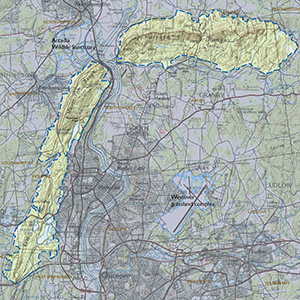Important Bird Area Sites in Massachusetts
Important Bird Area: Mount Holyoke/Mount Tom/East Mountain Range
Site Summary
Nominated By
David McLain
Size
8,000 acres
Towns and Counties
Amherst, Belchertown, Easthampton,Granby, Hadley, Holyoke, South Hadley,West Springfield, Westfield; Hampshire, Hampden
Ownership
Department of Conservation and Recreation, municipal, private, The Trustees of Reservations
Major Habitats
75% oak-conifer transition forest, 10% northern hardwood forest, pitch pine/scrub oak, early successional shrubland, cultural grassland, emergent freshwater marsh, palustrine woodland swamp, shrub-scrub wetland, lake/pond, river/stream
Land Use
nature conservation, hunting/fishing, recreation, quarry, water supply, research, undeveloped
Serious Threats
pests and disease
Minor Threats
non-native invasive plants, cowbirds, extraction industry, recreation overuse
IBA Criteria
- Category 1: Sites important for long-term research and/or monitoring projects that contribute substantially to ornithology, bird conservation, and/or education.
- Category 2: Sites containing assemblages of species characteristic of a representative, rare, threatened, or unique habitat within the state or region.
- Category 4: Land Birds: The site is an important migratory stopover or seasonal concentration site for migratory land birds (e.g., warblers). Sites may also qualify on the basis of supporting exceptionally high densities of breeding species as shown from point counts or other surveys or if they represent "migrant traps" relative to surrounding areas. Strong consideration will be given to areas with consistently high overall species diversity.
- Category 5: Raptors: The site is a bottleneck or migration corridor for more than 5,000 migratory raptors during a migration season.
Site Description
The Mount Holyoke Range is one of the few ranges that run east-west, while Mount Tom and East Mountain run north-south. The Connecticut River cuts between Mount Holyoke and Mount Tom. The entire range is a prime bird migration route, with its close proximity to the Connecticut River. The large tracts of forest provide important breeding habitat for interior forest birds. Peregrine Falcons once nested on the rocky cliffs of Mount Tom and could again in the future. Several ponds/reservoirs, bordering emergent wetlands, shrub and forested wetlands, vernal pools, woodland streams, rocky cliffs, rocky balds, boulder and talus slopes, red cedar thickets, and grassy former ski slopes add to the richness of the habitat. The surrounding region has become fragmented with urban development, making the mountain range an important corridor for large mammals and other wildlife. Holyoke Reservoir watersheds add protection and increase the diversity of birds.
Current Conservation Status
There are various threats to the environment in this IBA. Hemlock Woolly Adelgid is a recent invader and threatens the integrity of the forest. Cowbird parasitism is probably less intense than in the lower, fragmented valley. Butternut canker is threatening a stand of large trees on the northeast side of Mount Tom. Development has been proposed for areas around Whiting Street Reservoir and Mount Park. Residential development was avoided on Mount Holyoke. Radio towers and windmills already exist on top of Mount Tom. A gravel quarry adjacent to the ski area has requested to excavate a larger area. A former ski area has now been purchased by DCR. Some of the old ski slopes could be maintained as shrub-sapling habitat for early successional species. The Whiting Street Reservoir is a public drinking water supply but has been taken off-line. Subsequently, there has been interest from developers in the area. A development on Mount Holyoke was headed off by strong opposition from interested groups and eminent domain by DCR. Ashley Reservoir in Holyoke is a public drinking water supply within a protected watershed.
Ornithological Significance
This IBA is a historic nesting site for Peregrine Falcons on rocky cliffs, with the potential for future nesting there. It is also an important nesting habitat for the Whip-poor-will; Worm-eating, Black-and-White, Blackburnian, Black-throated Blue and Cerulean Warblers; Louisiana Waterthrush; Eastern Towhee; Eastern Wood-Pewee; Hairy Woodpecker; Baltimore Oriole; Rose-breasted Grosbeak; Scarlet Tanager; Wood Thrush; and Veery-priority species by Partners In Flight for southern New England. The ranges are a migration route for large concentrations of Broad-winged, Sharp-shinned and Cooper's Hawks, and American Kestrel, as well as several other species including the Northern Goshawk, Red-shouldered Hawk, Merlin, Peregrine Falcon, Osprey, and Bald Eagle. They are also a significant stopover for numerous migrant songbirds including 22 warbler species, as well as good numbers of breeding interior forest birds. Important habitat for birds includes Scrub oak habitat on ridgetops, large continuous tracks of mature northern hardwood forest and oak-conifer forest. Hawk watching coverage has included an annual spring migration count (Allen Bird Club) and the yearly Christmas Bird Count.
Other Flora or Fauna of Significance
Marbled Salamanders and Jefferson's Salamanders breed in a pool near the Route 141 entrance to Mount Tom. Spring Salamanders are found in a woodland stream on the range. Copperheads and Timber Rattlesnakes are found on Mount Tom's southwestern talus slopes, and their populations are probably very low. Over 20 rare plant species are also found on the range, including Climbing Fumitory, New England Blazing-star, Green Rock-cress, Black Cohosh, grasses, sedges, and others. Approximately 47 tree species. The ranges are an important corridor for large mammals including fishers, mink, bobcats, and black bears. The Hoary Edge and Edward's Hairstreak are uncommon butterflies found along the ridges.
Data Sources
Christmas Bird Count, Allen Bird Club spring migration count, pers. obs. (D. McLain, T. Gagnon, G. LeBaron, W. Lafley)




